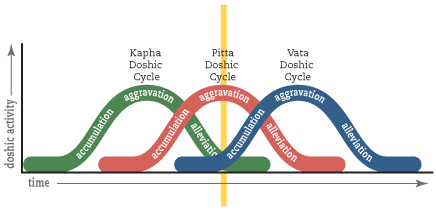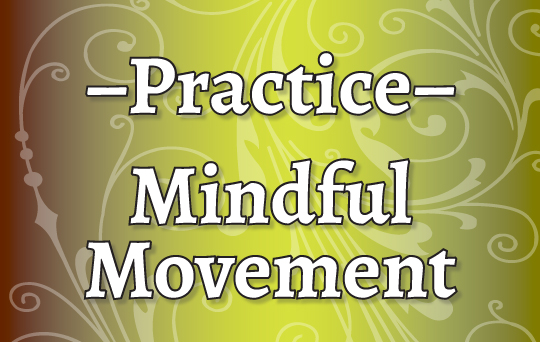Change. It is a constant in life. Day becomes night; one season gives way to the next one; and the years slip by into decades. Ayurveda knows that these natural rhythms are a basic part of life, and so rather than giving into stress around change, Ayurveda embraces it and prepares for it.
The three doshas of Ayurveda (Kapha, Pitta, and Vata) each take a turn being the predominant energetic. They do this during a 24-hour period; they do this during a calendar year; and they do this during a person’s lifetime. (They also do this dance during larger measurements of time.) Each dosha takes a turn gaining strength (“accumulating”), peaking (“aggravating”), and then dropping back down to a baseline (“alleviating”). It look something like this:

Each dosha has a time, a naturally-occurring rhythm where it increases in strength and expression, peaks, and then drops back off again so that the next dosha can take its turn doing the same thing. When you put the three doshas together in this model, it looks like this:

What you’ll notice is that all three doshas are doing something at any moment in time; they don’t take turns. That is to say that they overlap in their rise and fall rather than taking turns. At any one moment, one of the doshas is accumulating; another is aggravating; and the third is alleviating. They are each operating in their own rhythm at the same time that the other two doshas are moving in their pattern. It’s like an orchestra playing music as a coordinated whole instead of a single instrument playing at a time. So, as in this example, Vata is alleviating while Pitta is aggravating and while Kapha is accumulating.

{Do you like my homemade graphics?}
We see this dynamic taking place around us all the time in the natural world. Winter always gives way to spring over an extended period of time; it isn’t that winter stops and spring begins. There is a fading out of one energetic and a simultaneous fading in of another energetic. Thus, we are always in a state of transition. This cycle of the doshas (as I call it) is going on around—and within—all of us, all of the time.
What’s interesting is that different people have different rates at which they move and take in information.
Some people are quick; some people are slow; some are in the middle.
Some people relish change; some people hate change; some people are neutral to it, knowing that it’s inevitable.
Kapha Dosha
With its composition of earth and water elements, Kapha is a very stable energetic. It hates change and really wants things to stay the same. Kapha is very slow to change, and usually has to be coerced through inexorable outside forces.
Pitta Dosha
Pitta knows and accepts that change happens, so Pitta generally rolls with change pretty well. It finds a way to work with the dynamic of change, to innovate and experiment. Pitta can adapt its workflow patterns to accommodate a new circumstance.
Vata Dosha
Because of its air and water elements, Vata is all about change, the more and the faster the better. Vata is on the frontier of technological innovation and is an “early adopter.” Vata loves to take information in and to have experiences.
Ayurveda is concerned with each of us finding balance. When it comes to absorbing change, each of the doshas has an inherent strength and an inherent challenge.
- Kaphas are very considerate and careful in their decision-making. Sometimes they could throw caution to the wind and be spontaneous.
- Pittas do pretty well with change; they are decisive, after all. They could be more oriented to play and dreaminess and less focused on being productive.
- Vatas like to move fast; they are very good at it. And they could use some slowing down since they tend to make mistake in their haste.
And sometimes just knowing that there are different strokes for different folks is healing in and of itself. You can ask your friend who is zooming around to taking it down a notch, and your friend who is lagging behind can pick up the pace a little bit.







